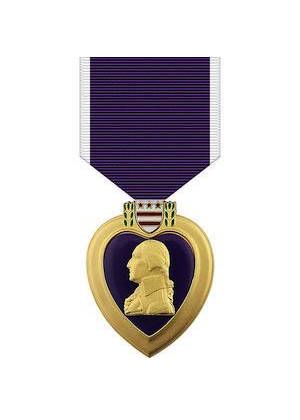American Patriot Warriors

 The Purple Heart
The Purple Heart 
First Issued by General George Washington on August 7, 1782 -
"The General ever desirous to cherish a virtuous ambition in his soldiers, as well as to foster and encourage
every species of Military Merit, directs that whenever any singularly meritorious action is performed, the author
of it shall be permitted to wear over his left breast, the figure of a heart in purple cloth . . . Not only instances
of unusual gallantry but also of extraordinary fidelity and essential service shall be met with a due award."
On February 22, 1932, the Army announced in General Orders No. 3 that "the Purple Heart, established by General George Washington
in 1782" would be "awarded to persons who, while serving in the Army of the United States, perform any singularly meritorious act of
extraordinary fidelity or essential service." Then, in a parenthetical in this announcement, the Army published the following sentence:
"A wound, which necessitates treatment by a medical officer, and which is received in action with an enemy of the United States, or as
a result of an act of such enemy, maybe construed as resulting from a singularly meritorious act of essential service." This meant that
the Purple Heart was an award for high-level service, but it also meant that an individual serving "in the Army" who was wounded in
action, could also be awarded the Purple Heart. Not all wounds, however, qualified for the new decoration; the wound had to be serious
enough that it "necessitated" medical treatment.
After America's entry into World War II in December 1941, and the deaths of thousands of soldiers in Hawaii and the Philippines, the War
Department recognized that those who had given their lives in defense of the nation must be recognized. Consequently, on 28 April 1942,
the Army reversed it's original policy and announced that the Purple Heart now would be awarded to members of the military service
who are killed or who died as a result of a wound received in action on or after December 7, 1941."
Five months later, the Army made another major change in the award criteria for the Purple Heart: it restricted the award of the Purple
Heart to combat wounds only. While MacArthur's intent in reviving the Purple Heart in 1932 was that the new decoration would be for "any
singularly meritorious act of extraordinary fidelity or essential service" (with combat wounds being a sub-set of such fidelity or service),
the creation of the Legion of Merit in 1942 as a new junior decoration for achievement or service meant that the Army did not need two
medals to reward the same thing. The result was that the War Department announced that, as of 5 September 1942, the Purple Heart was
now exclusively an award for those wounded or killed in action. About 270 Purple Hearts for achievement or service and not for wounds
were awarded prior to this change in policy, which makes them exceedingly rare.
President Franklin D. Roosevelt signed an executive order on December 3, 1942 giving the Secretary of the Navy the authority to award
the Purple Heart to any sailor, marine or Coast Guardsman wounded in action against an enemy of the United States or killed in any action
after December 7, 1941.
President John F. Kennedy signed an executive order on April 25, 1962 that permitted the Purple Heart to be awarded to any person
wounded or killed "while serving with friendly foreign forces" or "as a result of action by a hostile foreign force." By 1973, when the last
U.S. combat forces withdrew from Vietnam, thousands upon thousands of Americans wounded or killed in Southeast Asia had been awarded
the Purple Heart.
In February 1984, when President Ronald Reagan recognized the changing nature of war and signed Executive Order 12464. This order
announced that the Purple Heart could now be awarded to those killed or wounded as a result of an "international terrorist attack against
the United States."
On 25 April 2011, the Defense Department announced that the decoration now could be awarded to servicemen and women who sustained
"traumatic brain injuries and concussive injuries" in combat. This decision was based on the recognition that brain injuries caused by
improvised explosive devices (IEDs) qualify as wounds, even though such brain injuries may not be visible.
armyhistory.org

 The Purple Heart
The Purple Heart 

 The Purple Heart
The Purple Heart 